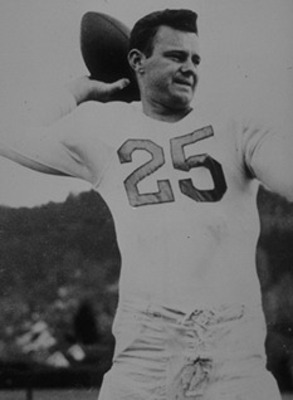
I made an executive decision last night to put off my next "Better Know the Units" entry in favor of a recap of the WAC's media day, specifically focusing on Coach Ault's portion which can be viewed here. I also have to tip my hat to Chris Murray's Twitter feed, which got most of the important stuff as it was said and gave me something to compare my account of the presser to.
~ Ault started by saying he had no interest in discussing anything Mountain West-related -- a no-brainer given the circumstances, of course, but still important for us as fans to remember.
~ With Steve Haley's return, he anticipates the offensive line returning four out of five players who've previously had starting experience.
~ He used the term "heir apparent" when referring to Zach Sudfeld at tight end, but also believed there'd be good competition among Stephen Jeffers and "two or three other players" at that spot.
~ "Tyler will throw the ball a little bit more than we did last year, but we are still going to run first;" he mentioned how excited he was to see Lantrip finally start, as he felt he's performed very well in his last two series of spring practices going back to his junior year; he listed Mason Magleby, Cody Fajardo and Tanner Roderick before saying "Our quarterback spot for the future is in good hands."
~ While there's no running back that stands head and shoulders above the others the way Vai Taua did, he felt there would be plenty of opportunities for each player to stand out at fall practices; he said that Stefphon Jefferson had the best spring of all the backs and that the position's depth will enable some good things to happen out of their two-back sets.
~ Khalid Wooten was referred to as the secondary's "fifth starter" playing at the nickel spot last year, and the secondary as a whole hasn't enjoyed their current level of depth in at least three years; he called the running backs and secondary the team's two strongest units at this time.
~ In the receiving corps he called Rishard Matthews "one of the best we've ever had there" and said they would look for multiple ways to utilize all of his talents; Tray Session is the fastest and most knowledgeable of the receivers, and along with Shane Anderson had to learn all three receiver positions last year; he hasn't found a specific replacement for Brandon Wimberly yet, but the list of potential replacements includes some players who are faster than him; the schedule means this group "has to get better in a hurry."
~ He raved about the strength of Brett Roy and Willie Faataualofa and the rotation they'll form with Zack Madonick; he pointed out a couple of times that Dontay Moch can't be easily replaced, but sounded pleased all the same with who he'll have at the ends.
~ James-Michael Johnson, Brandon Marshall and Brett Roy have to be the catalysts that lead the defense; "Our defense has to carry us and give that offense a chance to grow as we move;" he said they were "solid" but not great last year, and that "...I expect our defense to be very good this year."
~ Anthony Martinez will perform kicking duties, but there's no clear leader among the punters and it's a "very unsettled" position at this time.
~ He called Murray a "smart-aleck" when he jokingly asked about the Mountain West move. It's not an important observation, but it was still amusing to watch unfold, especially with the awkward silence and total absence of laughter that followed the joke.
~ In response to a question posed by Brian Murphy from the Idaho Statesman (I know the Mountain West also had their media days in Vegas this week, but why was he at this one? Habit? Boredom?) about BSU's current uniform drama: "I don't think we've ever lost to Boise's uniforms yet." Probably the most salient thing anyone has said on this whole issue to date. So thank you for that, Coach.
~ Bit of a weird question from someone at the Utah Statesman asking where he thought he'd be at the end of the year with Boise State gone. It was sort of hard to explain and phrased in a weird way. Coach went on to say some interesting things about his past experiences in moving from one conference to another and the extra significance each game on this year's schedule will have because of this.
~ An unknown reporter posed this next question. If Nevada found itself in an automatic qualifying conference -- be it the WAC or Mountain West -- Coach said the biggest difference would be the doors it would open as far as building a recruiting base would go.
~ Another Murray question, this one on the schedule. He said the schedule "is what it is" and also that the San Jose State game is every bit as meaningful as the Oregon game because of its position.
~ He says he's not concerned about carrying last season's momentum over as much as he's concerned about breaking in his new players and shoring up depth in the beginning third of the schedule.
~ When asked by someone about the WAC's future, he mentioned Karl Benson's prior experiences in building the league back up from defections and how important good, sound leadership at the top of a conference is; he goes on to say that ongoing relationships with other WAC programs regarding schedules will be important to Nevada and that the time they've spent in the WAC will be remembered fondly.
~ He concluded his time at the podium with the remark that he'll be more involved with scheduling from now on but that the athletic director will obviously still have the final say.











